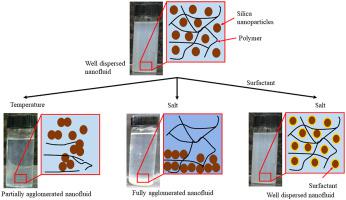Journal of Petroleum Science and Engineering Pub Date : 2020-07-31 , DOI: 10.1016/j.petrol.2020.107704 Krishna Raghav Chaturvedi , Tushar Sharma

|
Single-step nanofluids have shown better stability and size control properties than conventional two-step nanofluids under similar conditions. However, for wide-spread oilfield acceptance, there is a need to investigate the role of oilfield conditions viz., temperature, salt and pH on stability of single-step nanofluids. Thus, in this study, single-step silica nanofluids were synthesized in base fluid (1000 ppm polyacrylamide, PAM) and their stability was investigated using methods such as dynamic light scattering (DLS) and rheological analysis to establish their viability as suitable enhanced oil recovery (EOR) agents. PAM is a widely used oilfield practically applicable polymer. Primarily, the single-step silica nanofluids were found to destabilize at higher temperatures (≥90 °C) due to thermal stability issues of PAM at high temperatures. This was also understood by PAM rheology. The inclusion of salt reduced the stability of nanofluids due to the suppression of inter-particle repulsive forces. The variation in pH also influenced nanofluid stability and pH range of 8–10 was observed for the stable behavior of nanofluids. The addition of an anionic surfactant (SDS) improved nanofluid stability by reducing salt-induced NP agglomeration; increasing surfactant concentration initially improved nanofluid resistance to salt induced agglomeration and at high surfactant concentrations, the nanofluids exhibited greater NP agglomeration even in the absence of salt. The oil recovery results also showed that surfactant use in the synthesis of silica nanofluid for oil recovery applications may provide better results than sole silica nanofluid. Based on the observations, surfactant treated single-step silica nanofluid use was found favorable for oilfield practices where conventional nanofluids may show challenges.
中文翻译:

表面活性剂处理的一步法二氧化硅纳米流体在高温和盐度下的流变学分析和EOR势
在相似条件下,单步纳米流体已显示出比常规的两步纳米流体更好的稳定性和尺寸控制性能。然而,对于广泛的油田接受度,需要研究油田条件即温度,盐和pH对单步纳米流体稳定性的作用。因此,在这项研究中,在基础流体(1000 ppm聚丙烯酰胺,PAM)中合成了一步法二氧化硅纳米流体,并使用动态光散射(DLS)和流变分析等方法研究了它们的稳定性,从而确定了其作为提高采油率的可行性。 (EOR)代理商。PAM是广泛使用的油田实用聚合物。首先,由于PAM在高温下的热稳定性问题,发现一步法二氧化硅纳米流体在更高的温度(≥90°C)下不稳定。PAM流变学也可以理解这一点。由于抑制了颗粒间的排斥力,盐的加入降低了纳米流体的稳定性。pH值的变化也影响了纳米流体的稳定性,并且观察到pH值在8–10的范围内才能获得纳米流体的稳定行为。阴离子表面活性剂(SDS)的添加通过减少盐诱导的NP团聚提高了纳米流体的稳定性;增加表面活性剂浓度最初改善了纳米流体对盐诱导的团聚的抗性,并且在高表面活性剂浓度下,即使没有盐,纳米流体也表现出更大的NP团聚。采油结果还表明,在用于采油应用的二氧化硅纳米流体的合成中使用表面活性剂可能比单独的二氧化硅纳米流体提供更好的结果。根据观察,










































 京公网安备 11010802027423号
京公网安备 11010802027423号